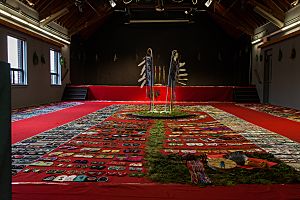Walking With Our Sisters facts for kids
Walking With Our Sisters is a special art display that helps us remember and honor missing and murdered Indigenous women and girls. It's made up of over 1,763 moccasin tops, called "vamps." Each pair of these moccasin vamps stands for one missing or murdered Indigenous woman from North America. It's a powerful way to show respect and remember those who are gone.
About the Project
The idea for Walking With Our Sisters came from Métis artist Christi Belcourt. She wanted to help families who were sad because their loved ones were missing or murdered. The project also aims to make more people aware of the issue of missing and murdered Indigenous women (MMIW). It creates a space for communities in Canada and the United States to talk about this important topic.
The project started in June 2012. Christi Belcourt used social media to ask people to make moccasin tops. These tops were to honor missing and murdered women. The first goal was to collect 600 vamps. But by July 2013, over 1,600 vamps had been sent in! More than 200 people from all over the world helped. In the end, over 1,725 pairs of vamps were donated. They were made by 1,372 artists. Many were from Canada, some from the United States, and a few from other countries. Along with the vamps, 60 audio recordings of songs were sent in. These songs play during the exhibits.
In 2014, the project grew to include 108 pairs of children's moccasin vamps. These were added to remember children who died or went missing. Many of these children were part of the residential school system. Families and survivors of residential schools were asked to contribute children's vamps. This happened when the exhibit was at Algoma University. This university is on the site of the old Shingwauk Indian Residential School. A special ceremony was held there to honor these children. Their vamps were then added to the art display.
How the Project Works
A group of volunteers called the Walking With Our Sisters Collective helps manage the art display. They plan where and when the exhibit will be shown. They also help communities get involved. An Elder and advisor named Maria Campbell guides the collective. She makes sure things are done respectfully. Other key members include Christi Belcourt and Tanya Kappo. Many other volunteers help with things like communication and supporting families. They also help set up the exhibit in different places.
Visiting the Exhibition
When you visit the exhibit, the space is treated like a special, traditional lodge. Visitors are asked to be respectful. This means not using cameras or phones. You also need to take off your shoes. Before entering, visitors are often offered a "tobacco tie." This is a small cloth bundle with tobacco inside. You hold it in your left hand, close to your heart.
The exhibit area is covered in red cloth. Visitors walk through the display in a clockwise direction. You are asked to stay on the red cloth and not step on the moccasin vamps. At the end of your visit, you return the tobacco tie. These ties are later burned in a sacred fire. Elders and volunteers are usually there. They can answer questions or listen to your thoughts after you've seen the display.
The Walking With Our Sisters exhibit has traveled to many places. It has been shown in cities across Canada and the United States. Some of the places it has visited include:
- University of Alberta, Edmonton, Alberta (2013)
- First Nations University Gallery, Regina, Saskatchewan (2013)
- Urban Shaman Gallery, Winnipeg, Manitoba (2014)
- Algoma University, Sault Ste Marie, Ontario (2014)
- Thunder Bay Art Gallery, Thunder Bay, Ontario (2014)
- Prince of Wales Northern Heritage Centre, Yellowknife, Northwest Territories (2015)
- Kwanlin Dun Cultural Centre, Whitehorse, Yukon (2015)
- Carleton University Art Gallery, Ottawa, Ontario (2015)
- Ziibiwing Centre, Mount Pleasant, Michigan (2016)


